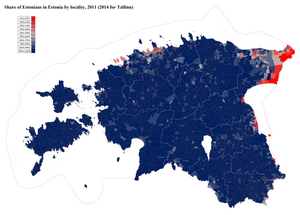Languages of Estonia
| Languages of Estonia [1] | |
|---|---|
| Official | Estonian |
| Minority | Russian, (Swedish, German) |
| Foreign | Russian (56%) English (50%)[2][3] Finnish (21%) |
| Signed | Estonian Sign Language, Russian Sign Language |
The official language of Estonia is Estonian, a Uralic language of the Finnic branch, which is related to Finnish. It is unrelated to the bordering Russian and Latvian languages, both of which are Indo-European (more specifically East Slavic and Baltic, respectively).
Minority languages[]
Russian[]

Russian is by far the most spoken minority language in the country. There are towns in Estonia with large concentrations of Russian speakers and there are towns where Estonian speakers are in the minority (especially in the northeast, e.g. Narva).
German[]
The Baltic Germans (German: Deutsch-Balten, or Baltendeutsche) were mostly ethnically German inhabitants of the eastern shore of the Baltic Sea, which today form the countries of Estonia and Latvia. The Baltic German population never made up more than 10% of the total.[4] They formed the social, commercial, political and cultural élite in that region for several centuries. Some of them also took high positions in the military and civilian life of the Russian Empire, particularly in Saint Petersburg.
Their history and presence in the Baltics came to an abrupt end in late 1939 following the signing of the Molotov–Ribbentrop Pact and the subsequent Nazi-Soviet population transfers when almost all the Baltic Germans were resettled by the German Government into the Wartheland and Danzig-West Prussia. Today there are very few Germans living in Estonia aside from some temporary residents from Germany. The German language is the third most popular foreign language among Estonians.
Swedish[]
The Estonian Swedes, are a Swedish-speaking linguistic minority traditionally residing in the coastal areas and islands of what is now western and northern Estonia. The beginning of the continuous settlement of Estonian Swedes in these areas (known as Aiboland) dates back to the 13th and 14th centuries, when their Swedish-speaking ancestors arrived in Estonia from what is now Sweden and Finland. Almost all of Estonia's Swedish-speaking minority fled to Sweden during World War II, and only the descendants of a few individuals who opted to stay are permanently resident in Estonia today.
Sign languages[]
The Estonian Sign Language (ESL, Estonian: Eesti viipekeel) is the national sign language of Estonia. In 1998 there were about 4,500 signers out a population of 1,600 deaf and 20,000 hearing impaired.[5] It is widespread in the cities of Tallinn and Pärnu among deaf ethnic Estonians; deaf Russian Estonians in Tallinn use Russian Sign Language, Russians outside Tallinn tend to use a Russian–Estonian Sign Language pidgin, or may be bilingual. In its formative stages, Estonian Sign Language was influenced by Russian and Finnish Sign Language; for example, the ESL sign for 'butterfly' developed from the Finnish sign for 'bird'. There are several dialects, the most archaic of which is the Pärnu variety.
References[]
- ^ "Europeans and their Languages" (PDF). Ec.europa.eu. February 2006. Retrieved 10 January 2018.
- ^ "SPECIAL EUROBAROMETER 386 Europeans and their Languages" (PDF). Ec.europa.eu. Archived from the original (PDF) on 2016-01-06.
- ^ More English spoken by young people than Russian, and English is rising in popularity while Russian is decreasing. Source: British Council's English Next report (2006), p. 93."Archived copy" (PDF). Archived from the original (PDF) on 2015-02-12. Retrieved 2015-02-07.CS1 maint: archived copy as title (link)
- ^ "Baltic states - region, Europe". Britannica.com. Retrieved 10 January 2018.
- ^ Henry, Sarah Hamrick, Laura Jacobi, Patrick Oberholtzer, Elizabeth. "LibGuides. Deaf Statistics. Europe". Libguides.gallaudet.edu. Retrieved 2017-03-26.
- Languages of Estonia
- Estonian language
